|
|
|
|
.
Red Line: Dan Ryan branch
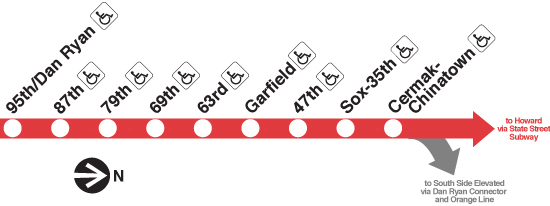 |
||||||||||
|
Legend:
Click on a station name to see that station's profile (where available) |
|
|
|
|
.
Red Line: Dan Ryan branch
 |
||||||||||
|
Legend:
Click on a station name to see that station's profile (where available) |
Service Notes:
History:
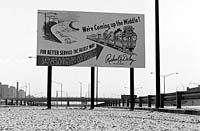 Several billboards featuring a cartoon of a crowded "L" train were placed in the median of the Dan Ryan Expressway to promote the upcoming construction of the median rapid transit line. One is seen here on April 19, 1967. For a larger view, click here. (Photo from the CTA Collection) |
Decades later, at a Chicago symposium commemorating the 50th anniversary of Mayor Richard J. Daley's first inaugural, former Representative Dan Rostenkowski shared an illustrative story about how federal funds are obtained, dispersed, and redistributed, and how the former mayor was able to have shift federal money from one side of town to another with a single telephone call. As reprinted in the Chicago Tribune, the story went as follows:
Rep. Dan Rostenkowski had just received a call from President Lyndon Johnson that the president was sending federal funds to run the "L" down the middle of the Kennedy Expressway in the congressman's Northwest Side 5th Congressional District. So Rostenkowski called Mayor Richard J. Daley to share the news."Oh really?" Daley said. "Did you get anything for the Dan Ryan?"
Rostenkowski told the mayor no, and about two hours later, Rostenkowski received another call from the president, telling him he had made a mistake.
"I meant the Dan Ryan," Johnson told Rostenkowski.
Rostenkowski protested and finally asked, "Mr. President, what's the Dan Ryan?"
"Goddamn you, I don't know what the Dan Ryan is," Johnson said. "I just got a call, and it's going down the Dan Ryan."
"When we got the money for the center [CTA] strip for the Kennedy, Daley called me and said, 'Come on, I'm going to let you drive the train,'" Rostenkowski said, laughing. "That was about three years later."
The Dan Ryan Line, constructed between 1967 and 1969, was the first of the two lines to open. Although its precise route changed somewhat through the early design process -- mostly in terms of how it would connect with the existing "L" system -- it was planned to follow the route of the South Expressway (renamed for Dan Ryan, President of the Cook County Board of Commissioners and one of the prime movers of the entire expressway system who died in 1961, before the expressway's opening in 1962) since the line's first appearance in a 1958 city transit plan.
The original scheme, included in the CTA's 1958 New Horizons for Chicago Metropolitan Area plan, called for a line extending south from 30th Street in the median of the South Expressway to a terminal at 103rd Street and Doty Avenue (near where the CTA Bus Division's 103rd Street Garage is today) with a Blue Island branch to 119th Street at the city limits. This project, with an estimated cost of $31,750,000 in 1958, would have also included a connection to the Englewood branch at 59th Street, with the incline probably located where 63rd Center Track is today. The line would have connected to downtown via a planned Wells Street Subway in addition to a new subway connection to the existing State Street Subway with a portal near 19th and Clark. The planned route was eventually culled back to 95th Street, with the branched extensions down Interstate 57 and Interstate 94 to be built at later dates. (Although these remained in long-term transportation plans for decades, neither has come to fruition.) In addition, the north end connection to the rest of the system was changed to be made with the elevated lines rather than the subway, although this was deemed to be temporary as a subway connection was still desired in the long-run.
As built, the line began at 17th and State streets, where it branched off the city's oldest rapid transit line, the South Side Elevated, at what became 17th Junction. The new line projected a few blocks west along 18th Street on a concrete-decked elevated structure to Clark Street, where it curved south to an alignment paralleling the Penn Central Railroad. Just south of its first station at Cermak-Chinatown, the Dan Ryan Line descended into the median of a feeder branch of the Dan Ryan Expressway (sometimes referred to as the "Franklin Connector", although it was never built to its full length and thus does not actually hook into Franklin Avenue). At 29th Street, the rapid transit line dives under the junction of the feeder and the Dan Ryan Expressway and ascends into the median of the Dan Ryan. From this point south to the terminal at 95th Street, the Dan Ryan "L" line runs in the median of the Dan Ryan Expressway. The expressway itself moves slightly in alignment from about 200 West to the east-west address median at 0 East/West, but generally follows a pathway due south from downtown.
The commemorative brochure published for the opening of the line describes the new route:
"The Dan Ryan line provides a 20.5 mile direct transit route between the south and west sectors of the city. Passengers boarding trains at the 95th Street terminal can travel to the Loop in 20 minutes. They can transfer to other CTA services along the way, or remain on board the same train and travel west on the Lake Street line to Oak Park and Forest Park, completing the entire trip in 45 minutes."
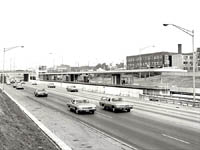 This view of 79th station in 1969 shortly before the Dan Ryan Line opened demonstrates Skidmore, Owings & Merrill's design for the Dan Ryan and Kennedy stations. Designed in the International style, the stations have a rectilinear shape with a formal and functional arrangement expressed in an open floorplan allowing for maximum efficiency, light, and purity of structure. For a larger view, click here. (CTA photo, from Graham Garfield Collection) |
The design of the nine stations of the Dan Ryan line was carried out by Skidmore, Owings & Merrill under the direction of Myron Goldsmith, who developed a modern, functional form in the late International style popular at the time. Improved visibility and security, ease of cleaning and more comfortable working conditions for CTA employees were design goals. Skidmore took the Kennedy-Dan Ryan ("KDR") project in a unique direction, designing all aspects of the new lines to harmonize in both shapes and materials. All windbreaks, dividers, and ticket booths were stainless steel. The supports of the transparent platform canopies and the structures of the station enclosures are white-painted steel frames, and the enclosures themselves are glass. The formal and functional criteria were expressed in several ways: open, uncluttered, brightly lit interior spaces; durability, safety, maximum efficiency of movement; lightness and purity of structure. The shape of everything, from the buildings to the agents' booths to the trashcans, followed a seamless design philosophy, which perfectly captured the boxy, purely functional International Modern style for which Skidmore is so well known.
The commemorative brochure describes the stations this way:
"The new rapid transit facilities were planned to provide a balanced system coordinated with other existing transportation serving the metropolitan area. Suburban and interurban bus lines will serve the 95th Street terminal of the Dan Ryan Line.Nine stations serve the Dan Ryan Line... Wide visibility and a high level of illumination are characteristic features in all areas. Fare collection equipment and turnstiles are stainless steel and... escalators supplement stairs for movement between station levels. Stations in the expressway medians are constructed of steel and glass providing maximum visibility from adjacent streets and highways. The boarding platforms are long enough to accommodate 8-car trains... Steel framed canopies of translucent plastic [extend] beyond the center line of the tracks. Self-service infrared radiant heaters are located at windbreaks on the platforms.
Off-street bus transfer facilities are provided at the 95th Street terminal and at 69th Street station by means of bus bridges over the expressway traffic lanes. An off-street bus loop is also provided at the Cermak Road station..."
In terms of interior arrangement and design for the passenger, Skidmore generally followed the edict of modernist pioneer Mies van der Rohe that "less is more." Except for at a few locations (most notably the 95th Street and Jefferson Park terminals on the Dan Ryan and Kennedy, respectively), there were no concessions provided for passengers. Air conditioning and a compact washroom with a toilet were provided in the agents' booths. Restrooms were for employees only, although payphones for the public were provided. Stainless steel turnstiles, now an industry standard, were first used on the CTA here. The amenities and traffic circulation fit with the architectural design of the station: efficient but purely functional. Stations were designed with wide walkways and no blind corners, with turnstiles and agents booths arranged for maximum queuing and circulation effectiveness. The Dan Ryan and Kennedy stations were also set up to allow Pay On Train operation, but without all of the complicated gates and fare control rearrangement built into the Congress stations.
The stations' design even formed a harmony with the 150 rapid transit cars, the 2200-series units built by Budd, that were ordered to serve the new Kennedy and Dan Ryan lines. The cars used the same design philosophies and basic shapes. In addition, an entirely new system of signage with a redesigned typeface and clean graphic style (still used by CTA today, in a modified form) was designed as part of the project, making a fully integrated design throughout the entire project. Stations were spaced at between half-mile and one-mile intervals, reflecting an increasing spacing of stations prominent in the postwar period, with bus lines acting as feeders to the rapid transit line.
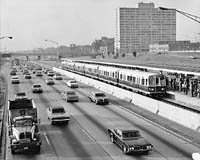 Looking south just a few days after beginning operation, a northbound Lake-Dan Ryan train is stopped at 69th station on October 1, 1969. The 6-car train is entirely made up of Pullman 2000-series cars. The crowd on the platform shows how the line was well-patronized from day one. For a larger view, click here. (Photo from the CTA Collection) |
The Ryan line was an early success, with the average number of weekday passengers on the route rising to 99,000 per day by the end of 1970, 10% over the expected total. The line's success had unintended consequences, however. The Dan Ryan line was not intended to replace the nearby, parallel Englewood-Jackson Park line, but supplement it and relieve congestion, in addition to providing "L" service south of 63rd Street. In fact, it did this all too well. As a result of several factors, including newer stations and equipment, a faster travel time, and not least of all a rerouted bus system that fed many of the Dan Ryan stations, the new line began siphoning riders off the old elevated route. The Dan Ryan did gain more than the Englewood-Jackson Park lost -- meaning that there was at least some net gain in ridership -- but the drop in ridership on the south end of the North-South Route was problematic.
Some minor service modifications were also needed after the line went into operation as usage characteristics dictated some tweaking. Less than a week after being service, passengers loads at some stations were different than expected, so 87th (having more riders than expected) was changed from an A station to an AB station, with 63rd switching from an AB to an A stop to maintain a skip-stop balance on the line. 95th Terminal also proved busier than predicted, requiring a fifth agent's position to be added in a third, temporary booth in October 1970. Service levels and train consist lengths were also adjusted early on. In April 1972, A/B skip-stop service was discontinued on Saturdays, with train lengths increased from two to four cars during Saturday daytime. Eight months later, in December 1972, the West-South Route began using 8-car trains during weekday rush hours and 4-car trains middays. In September 1977, Sunday train lengths were increased from two to four cars.
Later Developments
Certain elements of the Dan Ryan project, while forward-thinking and state-of-the-art at the time, proved to be problematic (or at least not up to expectations) in the long run. The concrete ties on the line were eventually replaced with traditional wooden ones. Concrete ties last about 30 to 50 years (about the same as treated pine or beech ties), but high-quality treated oak ties can last 100 years. The ties were replaced after they began to age badly, caused in large part by the trackbed and the drainage problems in the expressway median, and resulted in problems with track stability. Wayside signals were eventually installed at some locations to improve safety and provide redundancy.
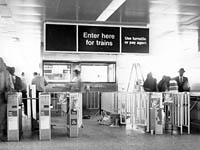 The finishing touches are being put on a new, permanent third agent's booth, with #5 and #6 agent positions, at 95th Terminal on July 2, 1976, one of the improvements made to the Dan Ryan Line in the 1970s. The station's traffic proved to be so high that the original four agent positions were insufficient during rush hour. The booth was put into service four days after the photo was taken. For a larger view, click here. (Photo from the CTA Collection) |
There were also some modest reductions in service due to CTA's budget crisis in the 1970s, although the Dan Ryan faired better than many routes thanks to its relative newness and its robust ridership. As mentioned previously, train lengths were increased and skip-stop service reduced, resulting in longer travel times for some riders. On January 13, 1973, the 33rd auxiliary entrance to Sox-35th was closed (one of many auxiliary entrances closed that year), reduced to a rotogate-controlled auxiliary exit.
In 1978, the Dan Ryan Line developed an unanticipated defect when several large cracks developed in the elevated structure at 18th and Clark streets. Service was immediately halted over that section of track when the defect was discovered on January 4, supposedly reported by a locomotive engineer on the Rock Island/Penn Central railroad tracks that pass underneath the elevated structure. During the emergency, trains operated only between 95th and Sox-35th on the Dan Ryan, with trains from Harlem terminating around the Outer Loop. A shuttle bus operated between Sox-35th and Tech-35th on the North-South Route. The defect took nearly two weeks to repair and through-service was not restored until January 17.
Some positive improvements were made in the 1970s, however. At 95th Terminal, the temporary fifth agent's position was replaced with a new, permanent, stainless steel booth matching the others with fifth and sixth agents' positions in July 1976. In October of that year, the West-South Route had the benefit of having the first four of the CTA's newest railcars, the 2400-series, placed in revenue service on the line as part of the prototypes 60-day acceptance testing.
As part of a general station modernization program, the CTA augmented the 79th station with a second entrance opposite the original station house on 79th Street. Featuring an open-plan design concept of the original headhouse, the five rapid transit stations rebuilt under the program included escalators and elevators for the convenience particularly of the elderly and handicapped. In 1977, the CTA opened the new auxiliary entrance/exit building on the north side of 79th Street. At the same time, the original entrance on the south side of 79th closed for reconstruction. The south side entrance reopened in 1980, including two levels of fare controls, one at street level and another at platform level. In the summer of 1981, a new elevator was put into service, making 79th the first Dan Ryan station to become handicap accessible.
Modest infrastructure improvements followed in the 1980s and early 1990s with a new 94th Interlocking placed in service in 1985 and a new 95th Interlocking was completed in 1990. In 1994, the diamond crossovers at 33rd and 44th were replaced with power-operated left-hand crossovers. A more significant change to the Dan Ryan Line was in the works, however...
A New Through-Route
A larger change was looming for the Dan Ryan Line as a result of its mismatched ridership with its through-routed partner. The Lake line had long suffered from poor ridership, caused in no small part by heavy competition from paralleling surface and rapid transit services spaced at closer intervals than the areas' density might otherwise suggest. Since the CTA took over, the line's ridership had continued to decline, exasperated by economic and social factors in the surrounding communities that were largely out of the CTA's control. As such, it was a poor mate for the Dan Ryan Line, whose ridership was projected to be quite high. Unless trains were short-turned on the Loop -- which CTA chose not to do -- the Lake end of the West-South Route would receive a high level of service not necessitated by its ridership to meet the Dan Ryan end's demand. The CTA , however, seemed to have little choice in its pairing. The cost of linking the Howard and Dan Ryan lines via a direct subway connection -- which the CTA and city had preferred to do and planned to accomplish eventually -- would have increased the already high cost of the Dan Ryan project.
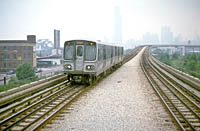 A 2-car Lake-Dan Ryan "A" led by car 2174 is approaching Cermak-Chinatown on August 2, 1974. As early as the 1970s, the CTA wanted to re-pair the Dan Ryan Line with the Howard Line but had insufficient funds to do so. When ground was broken in 1985 for the connection, this site would become the location of Cermak Junction, where the new subway connection joined the existing Dan Ryan Line. For a larger view, click here. (Photo by Doug Grotjahn, Collection of Joe Testagrose) |
Finally, in November 1985, officials from the City of Chicago and the CTA broke ground on the project to unite the Howard and Dan Ryan lines via a new subway connection. The project, which was budgeted at $142 million in '85, contained more than just the cut-and-cover subway connection between the Dan Ryan line and State Street Subway. The linkup program included an expanded yard at 98th Street and a completely reconfigured and modernized yard at Howard, permitting the terminals to handle the additional rolling stock necessary for the realignment. Addison station was also to be rebuilt with an island platform to eliminate the need to switch North-South trains between tracks to make the service stop on the side platforms. The undertaking was intended to create smoother, more efficient operations and provide the CTA with the balanced ridership on its through-routes that would allow them to better rationalize service levels: in 1985, the Howard line had 98,000 daily boardings and the Ryan had 66,000 riders a day, while the Lake line had only 33,850 daily passengers and the South Side Elevated had about 45,000. In terms of similar ridership levels, the new mates would be a far better match. At the time of the groundbreaking, the project was expected to be completed in late 1988.
In reality, completing the new subway connection took a great deal longer. Construction of the new tunnel -- which extended from just north of the Cermak-Chinatown station at 18th and Clark to the unused extension tubes built into the State Street Subway in 1943 (intended for the Archer Avenue Subway) just south of Roosevelt station -- took nearly five years. The repairing was also not without a fair amount of controversy. The very economy that the CTA was trying to achieve -- readjusting service intervals on the Lake and Englewood-Jackson Park branches to a level in line with the routes' ridership and demand levels -- was seen as unfair by politicians and citizens of the affected communities. They felt that reducing the existing level of service was making transit undesirable or more difficult for those neighborhoods, many of whom already shouldered a high level of disinvestment and unemployment. In addition, a group of four alderman called for Mayor Daley to stop the realignment just a week before it was to take place, charging that the new through-routes would, in their words, levy a "black tax" on the African-American riders who they claimed would have to pay to transfer between services from the south to the west sides, whereas they previously had a one-seat ride. The aldermen pointed out that passengers would have to pay for a transfer and walk more than two blocks to make the new south-west connection. (Free L-subway transfers had previously been available between the North-South and West-South routes at the State/Lake elevated station and the Lake-Randolph mezzanine of the Washington/State subway station, located less than a 1/2 block apart, with a specially-issued ticket from the agents at those stations but had been discontinued in mid-1983. After this, a transfer, which requires a surcharge to the base fare, was needed. The free L-subway transfer at State and Washington was reinstated on June 1, 1993, a few months after the realignment took effect.) As for the loss of a one-seat ride between the south and west sides (or the north and south sides), there was little detailed ridership information available that suggested that any more people took the Dan Ryan service to the Lake Street than would take Englewood-Jackson Park services to the same (or, on the flip side, that more would take one over the other to the Howard end). In point of fact, through-riding was probably fairly limited in the larger scheme of things, with the potential efficiencies of one route pairing over another benefiting the CTA more than the passengers.
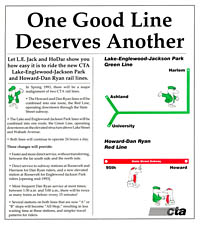 To educate customers about the impending rail route realignments taking effect in February 1993, the CTA issued a series of posters, car cards, and pamphlets, including the one pictured. Many of these publicity materials featured the HoDaR (Howard-Dan Ryan) and L.E. Jack (Lake-Englewood-Jackson Park), pictured on the right panel. For a larger view, click here. (Image from Graham Garfield Collection) |
The Red Line
The swap of the North-South and West-South routes officially occurred on February 21, 1993. Effective on this date at 0300 hours, the through-routes were reconfigured. Howard service was connected to the Dan Ryan line via the State Street Subway and new connector subway (forming the new North-South Route) and the Lake and Englewood-Jackson Park services were mated via the Lake and Wabash legs of the Loop and the South Side Main Line (creating the reformulated West-South Route).
With widened headways during much of the day, A/B skip-stop service was annulled on the entire West-South Route and the Dan Ryan portion of the North-South, as far north as Harrison station. Owl service was provided at 15 minute intervals on the North-South, but the 60 minute headways remained on the Lake, Englewood, and Jackson Park branches of the new West-South Route.
Another major change took place on the same day. The old route names -- including the "North-South Route" and "West-South Route" -- were discontinued along with the old routes. The CTA began using color-coded route names to make the lines easier to learn for tourists and new citizens, as well as to create visual continuity on maps and signage. The North-South Route (the realigned Howard-Dan Ryan) became the Red Line, while the West-South Route (now the Lake-Englewood-Jackson Park line) became the Green Line. The new roller curtains' color-coding changed from being indicative of the A/B stopping pattern to indicating the new route name, regardless of the skip-stop designation of the train.
The Red Line serves both of Chicago's baseball parks, Wrigley Field (home of the Cubs) at Addison and Comiskey Park (home of the White Sox) at Sox-35th. An Interesting Note: There hasn't been a World Series with both teams since 1906 (though this predated both the Dan Ryan Line and the use of both parks), but they do play the "Crosstown Classic" game against each other every year.
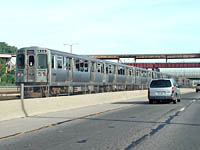 An 8-car Red Line train trailed by car 2754 is northbound passing 63rd Middle Track and through 59th Interlocking as it speeds along the Dan Ryan Expressway toward downtown and Howard terminal on September 13, 2002. Overhead is the Englewood branch of the Green Line. For a larger view, click here. (Photo by Graham Garfield) |
Several systemwide changes took place in 1997 that affected the Dan Ryan Line. In 1997, the CTA switched to its present electronic fare media, with farecards dispensed and recharged in vending machines in the stations and new turnstiles to utilize the media. On August 25 of that year, the ticket agents were converted to Customer Assistants at nearly all Dan Ryan stations and all fare collection was now through Automated Fare Collection (AFC) equipment only. The exceptions at that time were 69th and 95th stations, which followed soon after. In October 1997, new roller curtain destination signs installed on all Red Line railcars. Readings now showed the destination of train instead of route name. One month later, on November 9, one person train operation was initiated on the Red Line. Motormen and conductors were replaced by a single operator, who operated the train, opened and closed doors and made announcements. Running time was increased due to one-person train operation and the moderately increased dwell times at stations that resulted from operators working the doors and operating the train. For a short time, conductors were still assigned to ride all trains six cars or longer through the subway from Fullerton to Cermak. While on the train, they operated the doors from the rear unit and made announcements. This practice was eliminated in March 2000, in part due to the acclimation to one-person train operation as well as the installation of safety mirrors and monitors at stations with limited visibility along the platform from the motorcab. That same year, on February 6, the prerecorded announcement system was activated on the Red Line.
Several improvements were made to the Dan Ryan Line in the early 2000s. As part of a larger systemwide renovation program, an elevator was added to Sox-35th in 2000, providing ADA compliance. 95th/Dan Ryan received an elevator in 2001 under the same program, making the terminal accessible. In 2003, Sox-35th was further renovated with new flooring, lighting, Customer Assistant kiosk, and other improvements at the 35th entrance to that station.
By the 21st century, the Dan Ryan Line was in need of a makeover. Although the line was barely over 30 years old, certain aspects of the route were aging poorly while others were simply unable to meet the demand being placed upon them. For instance, since the Dan Ryan opened for service in 1969, the CTA has put more trains into service and increased the frequency of service to keep up with customer demand. In 1969, the West-South Route ran six-car trains with rush hour intervals at 5-7 minutes. Today, the Red Line runs eight-car trains with rush hour intervals at 3-5 minutes. In addition, railcars originally placed on the line over 30 years ago did not require as much power to operate as today's railcars. Improved customer amenities such as more powerful air conditioning systems require more power from the third rail to operate.
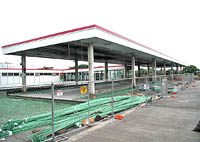 Phase One of the reconstruction of the 95th/Dan Ryan bus terminal, seen here on August 31, 2003, was nearing completion and would soon transition into Phase Two. For a larger view, click here. (Photo by Graham Garfield) |
The first stage of the project involved rehabilitating the bus bridges at 69th and 95th stations, two major intermodal facilities on the Dan Ryan Line. On April 3, 2003, the Chicago Transit Board approved a $4.5 million contract to renovate the 69th and 95th/Dan Ryan bus bridges as well as the bus turnaround at 95th Street. The bus bridge element of the project included rehabilitation of bridge supports, replacement of the bridge deck including busway pavement, curbs and walkways, refurbishment of barriers and fencing on the bridge, and installation of a new lighting system. Steel girders were cleaned and painted. The bus turnaround at 95th station had all passenger islands, sidewalks and pavement replaced. The bridge and turnaround work did not significantly affect rail or expressway traffic. Repairs to abutments, piers, and retaining walls were minor. All improvements conformed to the Americans with Disabilities Act (ADA).
The contract for the bus bridge project was awarded to Chicago-based F.H. Paschen/S.N. Nielsen & Associates through a competitive bidding process. Work on the bus bridge and bus turnaround at 69th and 95th streets started in spring 2003 and lasted until November 2003.
The major portion of the Dan Ryan Red Line Rehabilitation Project began in 2004 and consisted of three phases. Phase I replaced crossover track, installed a temporary signal system to support existing and upcoming track work, and began contact rail replacement from Cermak Road to 95th Street. Phase II involved constructing two new substations, upgrading two existing substations and demolishing one substation; installing a new bi-directional signal system; finishing replacing the contact rail; and installing new fiber optic cable. Station renovations were performed during Phase III, including elevator installations at 47th and 69th stations and refurbishment of platform canopies at eight stations from Sox-35th to 87th, inclusive. The three phases were performed in successive order, although each phase overlapped with the next one by several months.
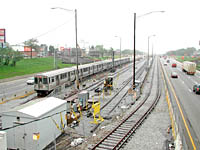 The 87th Interlocking runaround, or "shoe-fly", was in operation in this May 14, 2004 view looking north as a southbound Red Line train passes. The bypass allowed workers to replace the interlocking and do other work within the right-of-way more quickly, without the need to accommodate revenue trains on the same tracks that were being worked on. For a larger view, click here. (Photo by Graham Garfield) |
New traction power (third) rail and cabling was installed, in part to correct a problem with voltage drop previously experienced on the branch. Two new substations, at Pershing and 50th Street, were built and another two, at 27th and 79th streets, were improved. A third previously sited at 42nd Street was demolished.
New interlockings were installed at 10 locations on the branch, resulting in the elimination of the Dan Ryan's unusual switches operated from local panels and repeated left-hand crossovers between Cermak and 47th. Diamond or universal (a pair of left- and right-hand) crossovers were installed at all switching locations. The crossover and signal improvements on the Dan Ryan resulted in some interesting temporary operations to allow the new interlockings to be installed: the creation of temporary runaround "shoo-fly" tracks.
The shoo-flies consisted of bypass tracks in each direction located outside the current CTA right-of-way on the left Dan Ryan Expressway shoulder (adjacent to the CTA right-of-way) in each direction. The creation of these bypass tracks, each of which stretched between 1,000 and 2,000 feet, allowed the CTA to maintain uninterrupted bi-directional traffic on the Red Line while taking the permanent tracks out of service for replacement. Work performed in the bypass areas included the replacement of tracks and ties, installation of new specialwork such as crossovers, and the sinking of new traction power cables and substation connections. The runarounds were only being established where certain work was required, not along the entire branch.
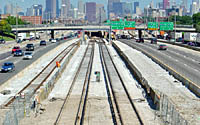 The 33rd Interlocking "shoe-fly" is no longer in use, seen looking north from the 33rd street bridge on August 31, 2004, and will soon be dismantled and removed. The new section of permanent track, along with the new 33rd universal crossovers and the overhead bridge for the new, yet-to-be-installed relay house, is also visible. For a larger view, click here. (Photo by Matthew Isoda) |
The CTA implemented runarounds at eight locations. Not all shoo-flies were in service concurrently. Typically, only two were in use at a time and each lasted approximately six to nine weeks per location. The first bypass to enter service was between 84th and 87th streets for the replacement of 87th Interlocking on April 3-4, 2004. Consequently, this was also the first bypass to be taken out of service, over the weekend of May 8-9, once work on the new permanent infrastructure was completed. The other seven shoo-flies were as follows, in order of implementation:
Work at the seven stations located between Sox-35th and 87th included refurbishing of platform canopies (including new skylight "bubbles"), architectural components, escalators, station entrances and station houses; addition of doors and storefronts on many station houses to make them enclosed structures; new station house and platform floor finishes, replacing the original aggregate with concrete; enhanced lighting; new customer assistant kiosks; and improved signs. Eight escalators along the branch were replaced and new elevators were installed at 47th and 69th, making the stations accessible to customers with disabilities. There were also enhancements to improve bus connections, such as curb cuts, canopies over station entrances and improved lighting on the approach to each station.
Dan Ryan renovation work was largely completed at the end of 2006, although some minor work continued into early 2007.
Red Line South Reconstruction Project: Dan Ryan Track Renewal
On November 3, 2011, Governor Pat Quinn, Chicago Mayor Rahm Emanuel, CTA President Forrest Claypool, several state lawmakers, and nearly a dozen aldermen announced a $646 million state capital investment grant to improve infrastructure on the Red and Purple lines. This latest investment comes from the $31 billion Illinois Jobs Now! state capital construction grant Quinn signed into law in 2009. In all, the state's share of the project tops $700 million, with another $255 million from the federal government, and about $44 million from the city of Chicago, for an overall commitment of $1 billion for several improvement projects on the Red and Purple lines.
Among the Red Line improvements is a project to replace the tracks between 18th and 95th streets and provide upgrades to stations between Cermak-Chinatown and 95th/Dan Ryan. As of June 2012, about 40 percent of the Dan Ryan branch was limited to speeds of less than 35 mph, with almost 20 percent of the branch restricted to a top speed of 15 mph. Without the investment, more than 60 percent of the Dan Ryan branch was projected to operate under slow zones by the end of 2012.
CTA officially announced the Red Line South Reconstruction Project on June 4, 2012. The track renewal project will rebuild the tracks from the bottom up, excavating down to the bottom of the trackbed to rebuild the underground drainage system, which has been problematic due to the expressway median environment and naturally-occurring clay that prevents water from properly draining away. This has destabilized the trackbed over time, leading to settlement and tie deterioration, and resulting in slow zones that are difficult to repair long-term even with regular tamping maintenance. The track renewal project will provide new ballast, ties, and tracks in addition to the rebuilt drainage system and trackbed. While a small amount of track work was undertaken during the 2004-07 Dan Ryan Red Line Rehabilitation Project, its scope was limited only to the interlockings and crossovers, short sections of track approaching those locations (required to remove the shoe-flies used during the replacement of the crossovers), and the third rail along the branch, replaced as part of the traction power upgrades. Running rail, ties, and trackbed were not improved along the majority of the branch under the previous work.
In order to perform the work more quickly and cost-effectively, the CTA announced in June 2012 that it planned to close the Dan Ryan branch for five months while work is performed. During that time, there would be no service on the Dan Ryan branch south of Roosevelt station. However, south of Roosevelt, Red Line trains would be routed via the old 13th Street Incline to the South Side Elevated, where they would operate to Ashland/63rd via the Green Line tracks in a pattern reminiscent of the old Howard-Englewood "A" trains of the North-South Route days. Harlem-Cottage Grove Green Line trains would continue to operate as well, but due to limited track capacity Green Line trains from Harlem that would've gone to Ashland/63rd were turned back to Harlem downtown during the weekday rush periods (at Roosevelt in the morning rush and via the Outer Loop in the evening rush). In addition, to further ease the impact on riders, CTA plans to offer multiple commuting options during this phase of the project, including:
The overall estimated budget for the project, including design, construction and additional CTA service, is $425 million.
CTA said that a work plan that only undertook work on weekends would take four years to complete versus the five months a complete shutdown will take. Although other track renewal projects were performed only on weekends in less time, such as on the O'Hare branch in 2007, the Dan Ryan job is more complex, requiring excavation down to the subterranean drainage system, whereas the O'Hare branch job did not require such work. The five-month construction option will also save $75 million over an option to perform work on weekends only. CTA plans to invest that $75 million savings into station upgrades along the south Red Line, such adding elevators to 87th, 63rd, and Garfield stations -- making the whole Dan Ryan branch, and indeed all "L" stations on the whole South Side, accessible -- lighting, painting, new roofs and canopies at some stations, electrical substation work, and other improvements.
On September 12, 2012, the Chicago Transit Board approved the award of a contract for the Red Line South reconstruction. Kiewit Infrastructure Corporation of Chicago submitted the lowest bid for the track work component of project at $220.1 million, and was found to be the most qualified. The bid was below project estimates, and the next lowest bidder was 20 percent higher than Kiewit's submission. Kiewit also slightly exceeded the CTA's target of 28 percent Disadvantaged Business Enterprise (DBE) participation -- reaching 29.3 percent -- by engaging the services of 23 DBE subcontractors, more than 50 percent of which are based in Chicago. The total DBE contact dollar amount is $66.5 million, with 60.6 percent going to African-American firms, 23.8 percent to Hispanic firms, 3.5 percent to Asian firms, and 12.1 percent to women-owned firms.
The station improvement portion of the project was bid separately. The Chicago Transit Board approved the award of the contract for station improvement work related to the Red Line South reconstruction project on November 14, 2012. F. H. Paschen, S.N. Nielsen and Associates, LLC ("Paschen") submitted the lowest bid for the station work component of the project at $43.875 million. CTA established a 40 percent Disadvantaged Business Enterprise (DBE) participation goal for station work, and Paschen met the CTA's target of 40 percent DBE participation by engaging the services of 13 DBE subcontractors.
The Red Line South reconstruction project began in Spring 2013, and lasted five months. The Dan Ryan branch closed on Sunday, May 19, 2013. Service resumed at 4am, Sunday, October 20, 2013.
Ever since the original plan for the Dan Ryan Line was cut back to the 95th Street terminal it opened with there have been plans and schemes to extend the route further south. Extension concepts have been included in the Chicago Area Transportation Study's (CATS') long-range transportation plans since just after the line opened, the first appearing in CATS' 1995 plan (published in 1973). The concept was maintained in CATS' later plans over the following decades. Originally, CATS advocated completing the original New Horizons Plan concept, which was to have one branch extend south along I-94 (the Calumet Expressway, now the Bishop Ford Freeway) to the vicinity of 103rd Street and a second branch to extend along I-57 (the Dan Ryan Expressway) to the vicinity of 119th Street or Blue Island. In CATS' conceptual plans, the Calumet branch was designated for "A" trains and the Blue Island branch was to be fir "B" trains in CTA's skip-stop service pattern.
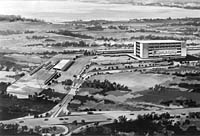 Artist's rendering of the proposed 103rd/Doty South Expressway Line terminal, including station, yard, maintenance, and park'n'ride garage facilities, from the 1958 New Horizons transit plan. For a larger view, click here. (Image from Graham Garfield Collection) |
CATS 2030 Regional Transportation Plan, Shared Path 2030, published in 2003, carried this concept forward. The latest version of the proposal is to extend the existing Red Line from the existing terminal at 95th Street to a new terminal at 130th Street and the Bishop Ford Freeway. A key component of the plan is an intermodal terminal and a major park-and-ride lot at 130th Street and the Bishop Ford Expressway. The terminal will provide connections with South Shore Line trains to Northern Indiana and Pace bus services to southeastern suburban areas. According to Shared Path 2030, "the extension is proposed to increase accessibility for residents of Chicago's far south side and southern suburbs. It is also designed to relieve congestion, reduce travel time and improve access to jobs for lower-income residents. The proposal should also promote economic development on Chicago's south side and in suburban areas. The project will provide direct access to CTA rail transit for commute and other trip needs, linking economically disadvantaged communities to jobs in Chicago's Central Area and the Lake Calumet industrial area.
The CTA , meanwhile, was beginning to set their sights on this project. After completing other extensions that had their origins in the same timeframe -- the extension to O'Hare, the new route to Midway -- the CTA began turning their attention to the Dan Ryan extension. The CTA also envisioned a longer extension than CATS, bringing the line south of 103rd to the city limits.
In 2005, the CTA began the long federal process for transit line planning. In July 2005, funding for five CTA New Starts projects was authorized as part of the reauthorization of the federal transportation bill, known as SAFETEA-LU (Safe, Accountable, Flexible, Efficient Transportation Equity Act - A Legacy for Users): the Red Line extension to 130th Street, along with an extension of the Orange Line to Ford City, an extension of the Yellow Line to Old Orchard, the Circle Line, and a Ogden Corridor project.
SAFETEA-LU will provide a total of $286.4 billion nationwide through 2009. Of that amount, $52.6 billion is earmarked for capital transit projects. For the period 2004-2009, Illinois is authorized to receive $2.6 billion in transit formula funds and CTA will receive approximately $1.3 billion of that amount.
At their November 9, 2005 monthly meeting, the Chicago Transit Board approved changes to the Authority's proposed 2006-2010 five-year capital plan in order to begin alternatives analysis studies for extending the Red Line, Orange Line, and Yellow Line. (Alternatives analyses were already underway at that time for the Circle Line and Ogden projects.) The alternatives analysis study is the first planning step in the Federal Transit Administration's New Start process for the purpose of pursuing federal funding. The studies will examine all of the transit options available and a locally preferred alternative will be determined.
The FTA New Starts program requires conceptual transit project proposals to proceed through a formal process of planning, design and construction. The FTA process consists of five formal steps: Alternatives Analysis, Environmental Impact Statement, Preliminary Engineering, Final Design and Construction. The alternatives analysis studies are designed to identify the preferred form of transit for the areas, routes, station locations, preliminary ridership estimates, constructability reviews and risk assessments, operating and capital cost estimates, and implementation schedules. The Board voted to set aside $6 million in capital funds for the three studies.
In order to secure the federal funding available under SAFETEA-LU, CTA must secure at least 20 percent in matching funds from non-federal sources. Securing CTA's formula funds for 2006 through 2009 -- not including New Start grants -- will require more than $200 million in matching funds.
The Dan Ryan extension took another step forward when, on September 13, 2006, the Chicago Transit Board approved a $3.5 million contract to Parsons Brinckerhoff Quade & Douglas Inc. to perform Alternatives Analysis studies for the proposed Red, Orange and Yellow line extensions. FTA Formula Funds provided the funding for the $3.5 million contract for Parsons Brinckerhoff Quade & Douglas, Inc., one of the world's largest planning, engineering, and program and construction management organizations with more than 150 offices worldwide.
Although CATS and the Illinois Department of Transportation (IDOT) have long advocated placing the extension in the median of the Bishop Ford Freeway (I-94), CTA is looking at other alignments as well, including via the Union Pacific right-of-way through Roseland and via the Metra Electric District right-of-way. Either of those options would then use the South Shore Line right-of-way to reach 130th and Doty. Other alignments are being examined as well. At its first public meetings for the extension study on April 10 and 11, 2007, the CTA recommended narrowing the nine options it's considering to three routes for further study:
The six other corridors that are under study in the Alternatives Analysis include using rights-of-way in the medians of Interstate 57 (the Dan Ryan) or Interstate 94 (the Bishop Ford), as originally envisioned in the original 1958 New Horizons Plan; or extending the Red Line tracks along or adjacent to Wentworth Avenue, State Street, King Drive or Cottage Grove Avenue/Metra Electric District main line. No recommendations were made at the April 2007 meetings regarding the alignment grade of the extension -- at street level, on elevated tracks, or in depressed open cut or underground -- but CTA officials did have a mode recommendation, suggesting using either traditional CTA heavy rail (i.e. the "L") or a bus rapid-transit system.
Extending the Red Line from its existing south terminal at 95th Street to a new terminal at 130th would streamline bus-to-rail connections for 12 CTA bus routes and six Pace routes and would also connect with the South Shore interurban railway and Metra's proposed SouthEast service commuter rail line. The Alternatives Analysis study examined all of the transit options available and determined a locally preferred alternative for the extension.
On August 12, 2009, the Chicago Transit Board voted to adopt the locally preferred alternatives proposed for the Red, Orange and Yellow Line extension projects. For the Red Line extension, the CTA recommends an elevated rail extension which would run from the current 95th/Dan Ryan station to 99th Street in the I-57 median, then turn south and southeast along or adjacent to the Union Pacific Railroad right-of-way until 120th Street, continuing at-grade to 130th Street. The extension would include 5.3 new miles of rapid transit, four additional stations -- at 103rd, 111th, 115th and 130th Streets -- with park & ride and bus terminal facilities at each station. The project would also include the purchase of new railcars to augment the fleet to provide service over the extension.
With the locally preferred alternative identified, the CTA then moved onto the Environmental Impact Statement (EIS) step of the FTA process. In 2011, the CTA received funding from the FTA to conduct the EIS for the Red Line Extension (RLE) project -- a major, important step in the multi-step federal process to secure approval and funding of the $2.3 billion dollar project. By April 2014, the CTA continued to move forward with the proposed Red Line Extension plan by beginning the second step of its environmental process to ultimately finish the EIS, which is required to begin engineering on the extension.
On August 10, 2014, the CTA announced that it had narrowed down to two preliminary options for the proposed RLE Project. Based on feedback received from the public in spring and summer 2014 via community meetings and comments provided to the agency, the CTA is now focusing on one "preferred alternative" with two possible variations from five proposals that have been under consideration. The CTA believes these options would best serve communities and residents on the Far South Side
The proposed alignment of the rapid transit line would be the same for the two East and West options north of 99th Street and south of 118th Street.
The full analysis for the preferred options, and separate, additional options that have been considered -- the Union Pacific Railroad Alternative Right-of-Way (ROW) Option, the Halsted Rail Alternative and the Bus Rapid Transit Alternative in lieu of a railroad extension -- will be part of the Draft Environmental Impact Study (EIS) currently being prepared by the CTA as part of the process of securing federal approval and funding for the project. Focusing on a preferred alternative in the draft Environmental Impact Statement will streamline the environmental planning process and accelerate the schedule for making the project eligible for federal New Starts funding.
The CTA expects to publish the Draft EIS by early 2015 for public comment and will hold public hearings to encourage feedback from the community. That feedback will be used to guide the selection of a final preferred option and the completion of the Final EIS, also a requirement of the federal project approval process.
On August 10, 2014, the CTA also announced $5 million of bond funds to move forward on the required federal planning process for the rail line extension. The CTA said the bond funds will help complete the Draft EIS and begin preparation of the Final EIS.
On January 26, 2018, Chicago Mayor Rahm Emanuel and the CTA announced that the agency had selected a preferred alignment for the Red Line Extension (RLE). After taking into consideration extensive public feedback, technical analysis and other factors, the CTA selected a route for the RLE project that would:
The preferred RLE alignment would provide all the benefits of new rail service for the area while minimizing the impact on local businesses and homes. The chosen path limits the number of properties the agency may need to acquire to up to 154 privately owned parcels, with 79 buildings and the rest vacant lots, CTA officials said. The alignment is a hybrid of two previously considered alignments -- the East and West Options, named for where they were located next to existing freight railroad tracks—and offers the best of each while limiting the number of properties CTA must purchase to build the rail extension. The selected alignment also takes advantage of several large parcels of land that are currently vacant and will allow for economic development opportunities.
The project is expected to create an estimated 6,200 jobs.
After hosting a public open house on February 13, 2018 to present the alignment to the community, CTA's will next produce a final Environmental Impact Study (EIS) that will include further preliminary engineering work and will analyze impacts of the proposed alignment. This engineering work is required before CTA can apply for more than $1 billion in federal funds to support the RLE project, estimated to cost $2.3 billion.
CTA expects to apply to the Federal Transit Administration (FTA) for entry into the Project Development Phase of this project, a necessary step to pursue federal funding for the project under the competitive federal “New Starts” program.
CTA officials noted that the timing of the project is dependent on funding -- the earliest construction would begin is 2022, and the project would take about four years. The CTA would have to pursue federal and local funds for the project. A state law gave the city the authority to establish tax increment financing districts to fund four transit projects, including the Red Line extension, but no decision has been made to pursue TIF for the project, CTA officials said.
In 2019, CTA took a critical step in moving the RLE Project forward by hiring a Program Management team to oversee the Final Environmental Impact Statement (EIS) and Preliminary Engineering. These steps will allow CTA to prepare materials that are needed to receive federal New Starts grant funding from the Federal Transit Administration (FTA).
In late 2019, an engineering survey was underway along the Preferred Alignment. The results of the engineering survey will be used in the Preliminary Engineering of the RLE Project. CTA anticipates hiring Preliminary Engineering and environmental consultants and beginning the next phase in early 2020.
CTA also received a grant through the FTA pilot program to prepare a Transit Supportive Development Comprehensive Plan. The grant will be used for planning efforts that will examine ways to encourage economic development and support ridership, foster multimodal connectivity and accessibility, identify public, nonprofit, and private partners, assess infrastructure needs and enable mixed-use development along the planned RLE corridor. Additionally, CTA’s study will analyze how Transit Oriented Development (TOD) can benefit households of varying income levels and ethnic backgrounds, which is known as equitable TOD, and support affordable housing.
On November 20, 2019, the Chicago Transit Board approved a 2020 $1.57 billion operating budget, and a capital budget that included a commitment to invest $310 million into the Red Line Extension project. This was the single most significant funding contribution that CTA had made to date towards the RLE project, and funded work efforts, including engineering and design activities, to help position the RLE project to receive federal funding.
The Chicago Transit Board approved a $38.3 million contract to T. Y. Lin International Great Lakes, Inc. on February 10, 2020, to provide planning and preliminary engineering services for the Red Line Extension, including preparation of the project’s Final Environmental Impact Statement (EIS). The work completed under this contract will allow the Red Line Extension project to advance through the Project Development phase, which is the next step of the federal funding process.
The contract has a base term of three funded years with six, unfunded, one-year options. T.Y. Lin International has committed to meeting a Disadvantaged Business Enterprise goal of 26 percent.
During the Project Development phase, CTA will also request that the Federal Transit Administration (FTA) begin to evaluate the Red Line Extension project for potential selection and funding through the New Starts program. Following Project Development, CTA will move into the Engineering Phase, which will position CTA to negotiate a Full Funding Grant Agreement with FTA.
The Final EIS will include and address all comments received during the public review period for the Draft EIS, which was completed in 2016. The Final EIS will document the results of the Draft EIS process, confirm the Preferred Alignment, and include a list of final mitigation measures to address any environmental impacts to the surrounding community. Preliminary engineering will advance the project’s design to 30%, which is also a requirement of the Project Development phase.
On December 21, 2020, CTA stated that it had received approval from the Federal Transit Administration (FTA) to enter the New Starts Project Development (PD) phase of the FTA’s Capital Investment Grants (CIG) Program for the Red Line Extension (RLE) project. Entering this phase was a major step in the CTA’s continued commitment to move forward the construction of the RLE project.
The CIG program provides partial funding for transit capital investments like RLE. Federal transit law requires transit agencies seeking CIG funding to complete a series of steps over several years including Project Development.
During the two-year Project Development phase, the CTA will complete the project’s Final Environmental Impact Statement (EIS) and preliminary engineering documents to successfully meet the federal requirements for this phase. As part of the CTA’s commitment to the RLE project, $310 million was included in 2020 capital budget towards 30% non‐Federal Capital Investment Grant match commitment, which is also one of the requirements to successfully complete the Project Development phase. Advancing through CIG program will allow the CTA to ultimately apply for more than $1 billion in federal funds to fund the RLE project, with an estimated cost of approximately $2.3 billion.
In recent years, the CTA laid the necessary groundwork to ensure it will achieve the milestones within the fast-paced two-year Project Development timeframe. As a result of these efforts, which include conducting additional in-depth analysis, undertaking additional coordination, and modifying the location of the 130th Street station, the RLE project now has an updated timeline. While the original project timeline estimated service to begin in 2026, it was based on limited information and published in 2016 as part of the Draft Environment Impact Statement. The CTA is confident in and committed to the new project timeline, which estimates the start of construction in 2025, and service beginning in 2029, all of which is dependent on securing project funding.
On August 12, 2022, the Federal Transit Administration (FTA) and the CTA, in cooperation with the Federal Highway Administration (FHWA), announced the publication of the combined Final Environmental Impact Statement (EIS)/Record of Decision (ROD) and Final Section 4(f) Evaluation for the RLE Project. This is a significant milestone that paves the way for the CTA to advance to the next steps of the federal New Starts funding program.
The ROD is the conclusion of the National Environmental Policy Act (NEPA) EIS process and is the official FTA decision document regarding the project’s environmental impacts and mitigation. The ROD and the Final EIS, which are combined into a single document, include a list of mitigation commitments related to the impacts identified in the Final EIS. The mitigation efforts documented in the EIS are a reflection of the public and agency engagement and feedback that have been vital to the development and refinement of the RLE Project since the publication of the Draft EIS in 2016 and the Supplemental EA in January 2022.
The CTA took the next major step in advancing the transformational Red Line Extension (RLE) project at the end of October 2022 by seeking the most qualified firms in the industry to design and build the 5.6-mile rail line extension. The agency looked to pre-qualify candidate teams that will be finalists in competing for the RLE design-build contract; this transformational project is expected to create 6,200 direct construction jobs.
As part of a two-step procurement process, the CTA announced on October 28, 2022 it would issue a Request for Qualifications (RFQ) to select a pool of the most qualified contracting teams that can demonstrate the ability to design and build the mainline infrastructure and stations portion of the RLE project. Commencing work on the RLE project is dependent on securing funding, however, by beginning this process of pre-qualifying potential contractors now will help expedite overall project development and ensure CTA maintains its timeline to begin construction as early as 2025.
Once a pool of candidate teams is finalized, CTA will then invite the potential bidders to submit proposals on how they suggest designing and building the RLE project when the agency issues its Request for Proposals (RFP), all of which is expected to occur in mid-2023. The proposals will be considered on a variety of criteria, including experience, price and other factors.
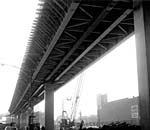 |
Constr-ROW@18th-Federal.jpg
(93k) |
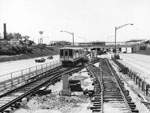 |
cta2200s05.jpg (229k) A two-car unit of 2200-series railcars -- probably cars 2201-2202 -- take a test trip on the new Dan Ryan Line, passing northbound through 94th Interlocking after leaving 95th terminal, on an inspection trip on June 27, 1969. Note the Greyhound bus on the bus bridge at the 95th station and the Sinclair gas sign in the left background. (CTA photo) |
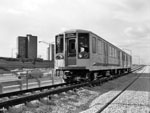 |
cta2201d.jpg (189k) 2200-series prototype cars 2201-2202 are posed on the new Dan Ryan Line near 35th Street during an inspection trip of the new facilities on June 27, 1969. The modern, streamlined stainless steel cars were built as part of and to provide service on the new line. Note the concrete ties used on the line, a feature of both the Dan Ryan and Kennedy lines built at the same time. Towers of the Robert Taylor Homes high-rise public housing development, completed just seven years earlier, are visible in the background. It appears someone forgot to "dress" the front of the train and properly secure the front chains! (CTA photo) |
 |
cta2203.jpg (234k) Cars 2203 (nearest to the camera) and 2204 are recently delivered from the Budd Company when they were at Skokie Shops in August 1969 undergoing inspection before being readied for service. The cars' clean, straight lines glisten in the midday sun. The ACI stripe has already been placed on the #2 door, which will allow the train to automatically set the route at Tower 12. (Photo by Walter R. Keevil) |
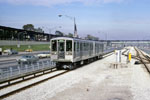 |
cta2212a.jpg (189k) A two-car Lake-Dan Ryan "B" train led by car 2211 speeds past 63rd Middle Track on October 25, 1969 on its way to 95th. The line is running two-cat trains because it is a Saturday. A little girl stands at the front window, getting an exciting look at the brand new "L" line. (Photo by Thomas H. Desnoyers, courtesy of the Krambles-Peterson Archive) |
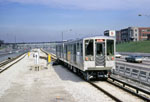 |
cta2219d.jpg (201k) A two-car 2200-series train has just departed 63rd station and is about to pass 63rd Middle Track on the month-old Dan Ryan Line on its way to the Loop and Harlem on the Lake Street branch on October 25, 1969. The rapid transit line and its rolling stock still look brand new. The train is lightly loaded, owing to it being a Saturday. The Englewood branch of the North-South Route is visible overhead in the background. (Photo by Thomas H. Desnoyers, courtesy of the Krambles-Peterson Archive) |
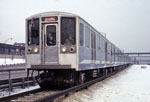 |
cta2246b.jpg (185k) Winter has set in and the new Dan Ryan Line is covered with a light coating of snow as car 2246 leads a six-car train of 2200-series cars heading southbound approaching 63rd station on January 4, 1970. The rail enthusiasts taking the trip are crowded at the front of the car to get a good look at the new line from the motorman's perspective. (Photo by George Krambles, courtesy of the Krambles-Peterson Archive) |
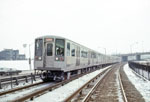 |
cta2249c.jpg (158k) Don't be fooled by the Congress-Milwaukee "A" destination sign -- someone was probably just having some fun -- this six-car train of 2200s led by car 2249 is heading northbound on the Dan Ryan Line near 66th Street on January 4, 1970. The train is chartered, being used on a fantrip -- one giveaway is that January 4 was a Sunday, when two-car trains were the norm. (Photo by George Krambles, courtesy of the Krambles-Peterson Archive) |
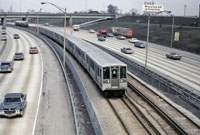 |
cta2269.jpg (231k) A long train of eight 2200-series cars is rounding the curve at Marquette on the Dan Ryan Line on its way southbound toward 95th on April 4, 1970. The train is probably chartered or operating for a special event -- besides the "Not in service" destination signs and another sign taped to the front window, it is a Saturday and the in-service train of Pullman 2000-series cars the train has just passed is only two cars. (Photo by George Krambles, courtesy of the Krambles-Peterson Archive) |
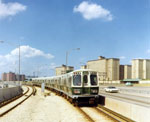
|
cta2000s09.jpg (192k) |
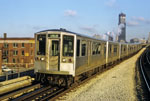 |
cta2280.jpg (225k) A solid 8-car train of 2200-series cars, led by car 2280, comes down the Dan Ryan connector elevated structure on the Near South Side, heading into Cermak-Chinatown station on its way to 95th on January 2, 1973. Note the Sears Tower under construction in the background. The rest of the downtown skyline is significantly different than it is today as well. (Photo by Art Peterson, courtesy of the Krambles-Peterson Archive) |
 |
cta2300b.jpg (197k) 2200-series car 2300 leads an 8-car southbound Lake-Dan Ryan "B" train approaching Cermak-Chinatown station on January 2, 1973. The remainder of the train is made up of 2000-series cars -- while attempts were commonly made to run the trains in solid like-series consists, practical considerations (permitted by the fact that the cars were compatible) often led to mixed consists being run. The tendency to do so led the 2000s to be repainted to a silver and charcoal scheme to provide a more consistent appearance when they were mixed with 2200s in a train. (Photo by Art Peterson, courtesy of the Krambles-Peterson Archive) |
 |
cta2174.jpg (198k) A 2-car Lake-Dan Ryan "A" led by car 2174 is approaching Cermak-Chinatown on August 2, 1974. As early as the 1970s, the CTA wanted to re-pair the Dan Ryan Line with the Howard Line but had insufficient funds to do so. When ground was broken in 1985 for the connection, this site would become the location of Cermak Junction, where the new subway connection joined the existing Dan Ryan Line. (Photo by Doug Grotjahn, Collection of Joe Testagrose) |
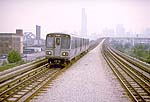
|
cta2063.jpg (113k) |
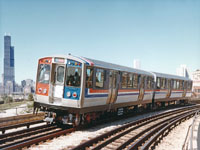
|
cta2401_preview.jpg (201k) |
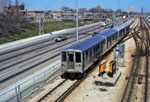 |
cta2242.jpg (285k) A four-car southbound Lake-Dan Ryan "B" train of mixed consist -- car 2242 leading the head 2200-series unit, trailed by the 2000-series set at the rear -- passes through 79th Interlocking, approaching 79th station on its way to 95th on April 8, 1976. (Photo by Art Peterson, courtesy of the Krambles-Peterson Archive) |
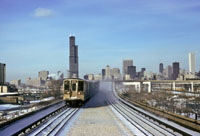 |
cta2204b.jpg (196k) Kicking up fresh snow on the right-of-way as the train speeds down the ramp from the Dan Ryan connector track towards Cermak-Chinatown station, car 2204 leads a southbound Lake-Dan Ryan "A" train on January 10, 1977. (Photo by Art Peterson, courtesy of the Krambles-Peterson Archive) |
 |
cta2242b.jpg (223k) 2200-series car 2242 brings up the rear of a northbound Lake-Dan Ryan "B" train near Marquette on the Dan Ryan Line heading toward the Loop and Harlem on January 21, 1977. The train is led by a Pullman 2200-series unit, but the aesthetic difference between the two car series has been reduced through the application of a new livery, replacing the original mint green and alpine white, designed by Sundberg-Ferar to make the two series flow better in mixed consists -- a silver body with a charcoal band through the windows to ramifies the difference in windows heights of the two car types. (Photo by Art Peterson, courtesy of the Krambles-Peterson Archive) |
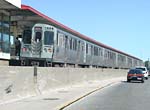 |
cta2937@47th.jpg
(143k) |
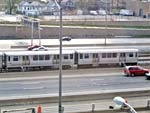 |
ROW@60th01.jpg
(148k) |
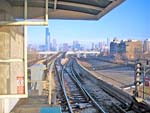 |
ROW@CermakJct01.jpg
(200k) |
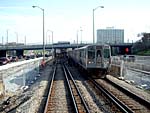 |
ROW@68th-runaround01.jpg
(179k) |
 |
ROW@33rd-runaround01.jpg
(190k) |
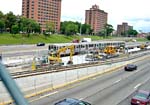 |
ROW@33rd-runaround02.jpg
(176k) |
 |
cta2401-02_S-601_2409-10.jpg
(158k) |
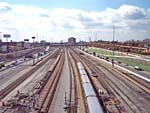 |
ROW@59th01.jpg
(200k) |
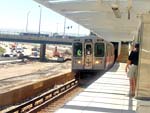 |
cta2839@47th.jpg
(111k) |
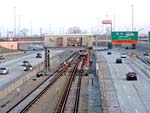 |
ROW@69thInterlocking01.jpg
(171k) |
|
|